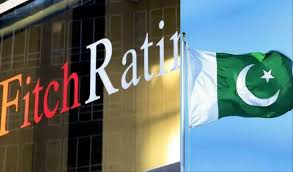ISLAMABAD – In a positive development for Pakistan’s economy, Fitch Ratings has upgraded the Pakistan credit rating from ‘CCC+’ to ‘B-’. The outlook remains stable. The rating agency cited stronger fiscal discipline, better external account management, and improved macroeconomic strategies as key reasons behind this change.
According to a statement released on Monday, Fitch’s decision reflects growing confidence in Islamabad’s ability to enforce tighter budgets and continue structural reforms. These improvements are part of the ongoing programme under the International Monetary Fund (IMF).
The Pakistan credit rating boost comes after the government reached an agreement with the IMF in March. The deal included a review of the $7 billion Extended Fund Facility (EFF) and the new $1.3 billion Resilience and Sustainability Facility (RSF). Fitch noted that the country’s monetary and fiscal policies remain tight, which supports reserve recovery and limits external financing pressures.
Despite the positive rating action, the agency warned that Pakistan still faces high financing needs. Risks tied to the implementation of reforms also remain.
Finance Minister Senator Muhammad Aurangzeb welcomed the upgrade. He said it reflects confidence in the government’s economic reforms. “This move will give more strength to our economic plan,” the finance minister stated. He added that the improved Pakistan credit rating would boost investor confidence, increase trade, generate jobs, and promote industrial growth.
He also expressed hope that this recognition would lead to more financial support and trust from global institutions and credit agencies.
The fiscal outlook has shown progress. The government expects the budget deficit to fall from almost 7% to 6% of GDP in the current financial year. This drop is driven by spending cuts and budget surpluses at the provincial level. The primary surplus is also set to more than double, crossing 2% of GDP.
Fitch highlighted that public debt dropped to 67% of GDP in FY24 from 75% a year earlier. The decline is expected to continue slowly. However, the cost of borrowing remains high. Interest payments could reach 59% of revenue in FY25, much higher than the ‘B’ category average of 13%.
Inflation is projected to decline sharply. It may drop to 5% in FY25, down from over 20% in the past two years. It is expected to rise slightly to 8% in FY26. The State Bank of Pakistan (SBP) has held its policy rate at 12% following earlier cuts in 2024. Economic growth is predicted to rebound to 3% during FY25.
The Pakistan credit rating also benefited from a stronger external position. The country posted a $700 million current account surplus during the first eight months of FY25. This was supported by higher remittances and lower import prices. Foreign exchange reserves rose to almost $18 billion in March, a sharp rise from under $8 billion in early 2023.
Still, challenges remain. Pakistan must repay $8 billion in external debt this year and another $9 billion in FY26. The government plans to raise $10 billion in the second half of FY25 through loans from multilateral and commercial sources.
On the political front, Prime Minister Shehbaz Sharif leads a coalition with a parliamentary majority. However, Fitch pointed out that the lack of a strong public mandate, political instability, and security threats in areas near the Afghan border are ongoing concerns.
Although its rating model placed Pakistan at a ‘CCC+’ level, Fitch’s rating committee upgraded it by one notch. The committee said the change was due to better inflation control and stronger management of macroeconomic policies.


